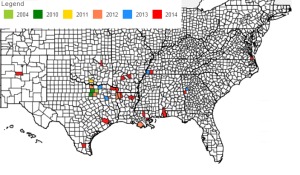It’s probably true that misery loves company. For the past several years we gardeners in the Dallas area have sadly watched our beautiful crape myrtle trees succumb to a new insect pest. The crape myrtle bark scale is a messy little critter that causes trunks to blacken and plants to drip sticky bug poop.
True, it’s small consolation to know that the scale that invaded Texas has now spread to at least six other states and appears to be ready to follow crape myrtle in the U.S. wherever it is grown. But at least we’re no longer alone in our woes.
The scale was positively identified this year as Eriococcus lagerstroemiae, an insect previously found only in and around China (including Korea and Japan). Most likely introduced to the Dallas area by a traveler smuggling a crape myrtle cutting to plant in a private backyard, we’ve known the scale problem for over ten years. Now the crape myrtle bark scale has its own website, and a distribution map that you can help update.
Identifying the pest is not difficult. It is one of very few white scale-like insects that will cluster on the bark of crape myrtle trunks and branches. When crushed they ooze a purplish blood.

The current range of the crape myrtle bark scale. You can help document the spread of this new pest at www.eddmaps.org/cmbs
The fine folks at EDDMaps (Early Detection & Distribution Mapping Sytem) have just finished creating an interactive way to share pictures and data about suspected crape myrtle infestations at your backyard or town. If you suspect you have the scale in your neighborhood, take a picture of the infested tree and save to your phone or computer. Then go to http://www.eddmaps.org/cmbs/ and register if you are a first time user. After you’re official, click on the Report Sightings tab and start filling in your information about your suspected infestation. You don’t have to manually enter Latitude and Longitude, simply use the interactive map to locate where your crape myrtles are located. If you zoom in and turn on the satellite image option (my favorite part) , chances are that you can point to the actual tree in question.
After you mark your location, you can upload up to five digital images and submit your report. The report goes to a local entomologist who verifies the image and your report goes into the mapping database. If your sighting is confirmed, your county will light up with a color indicating the year of your report, and your record will go down in the entomological archives forever.
The map itself will likely not help keep the scale from spreading. The USDA has determined that the cat is already out of the bag, and so there is no real use for quarantining nurseries in infested states. Nevertheless, we entomologists would like to know how fast it’s spreading. And, like telling teacher about a naughty child on the playground, even if we can’t stop this pest from spreading at least it will make you feel better to report it.
For more information about crape myrtle bark scale and its control, click here.
